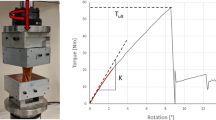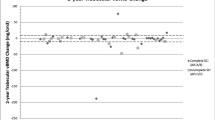Abstract
Summary
Computed tomography and finite element modeling were used to assess bone structure at the knee as a function of time after spinal cord injury. Analyzed regions experienced degradation in stiffness, mineral density, and content. Changes were well described as an exponential decay over time, reaching a steady state 3.5 years after injury.
Introduction
Spinal cord injury (SCI) is associated with bone fragility and an increased risk of fracture around the knee. The purpose of this study was to investigate bone stiffness and mineral content at the distal femur and proximal tibia, using finite element (FE) and computed tomography (CT) measures. A cross-sectional design was used to compare differences between non-ambulatory individuals with SCI as a function of time after injury (0–50 years).
Methods
CT scans of the knee were obtained from 101 individuals who experienced an SCI 30 days to 50 years prior to participation. Subject-specific FE models were used to estimate stiffness under axial compression and torsional loading, and CT data was analyzed to assess volumetric bone mineral density (vBMD) and bone mineral content (BMC) for integral, cortical, and trabecular compartments of the epiphyseal, metaphyseal, and diaphyseal regions of the distal femur and proximal tibia.
Results
Bone degradation was well described as an exponential decay over time (R2 = 0.33–0.83), reaching steady-state levels within 3.6 years of SCI. Individuals at a steady state had 40 to 85% lower FE-derived bone stiffness and robust decreases in CT mineral measures, compared to individuals who were recently injured (t ≤ 47 days). Temporal and spatial patterns of bone loss were similar between the distal femur and proximal tibia.
Conclusions
After SCI, individuals experienced rapid and profound reductions in bone stiffness and bone mineral at the knee. FE models predicted similar reductions to axial and torsional stiffness, suggesting that both failure modes may be clinically relevant. Importantly, CT-derived measures of bone mineral alone underpredicted the impacts of SCI, compared to FE-derived measures of stiffness.
Trial registration
ClinicalTrials.gov (NCT01225055, NCT02325414)



Similar content being viewed by others
References
Jiang S-D, Dai L-Y, Jiang L-S (2006) Osteoporosis after spinal cord injury. Osteoporos Int 17:180–192. https://doi.org/10.1007/s00198-005-2028-8
Edwards WB, Schnitzer TJ (2015) Bone imaging and fracture risk after spinal cord injury. Curr Osteoporos Rep 13:310–317. https://doi.org/10.1007/s11914-015-0288-6
Edwards WB, Schnitzer TJ, Troy KL (2013) Bone mineral and stiffness loss at the distal femur and proximal tibia in acute spinal cord injury. Osteoporos Int 24:2461–2469. https://doi.org/10.1007/s00198-013-2557-5
Edwards WB, Schnitzer TJ, Troy KL (2014) Reduction in proximal femoral strength in patients with acute spinal cord injury. J Bone Miner Res 29:2074–2079. https://doi.org/10.1002/jbmr.2227
Jiang SD, Jiang LS, Dai LY (2006) Mechanisms of osteoporosis in spinal cord injury. Clin Endocrinol 65:555–565. https://doi.org/10.1111/j.1365-2265.2006.02683.x
Biering-Sorensen F, Bohr HH, Schaadt OP (1990) Longitudinal study of bone mineral content in the lumbar spine, the forearm and the lower extremities after spinal cord injury. Eur J Clin Investig 20:330–335
Eser P, Frotzler A, Zehnder Y et al (2004) Relationship between the duration of paralysis and bone structure: a pQCT study of spinal cord injured individuals. Bone 34:869–880. https://doi.org/10.1016/j.bone.2004.01.001
Edwards WB, Simonian N, Troy KL, Schnitzer TJ (2015) Reduction in torsional stiffness and strength at the proximal tibia as a function of time since spinal cord injury. J Bone Miner Res 30:1422–1430. https://doi.org/10.1002/jbmr.2474
Vestergaard P, Krogh K, Rejnmark L, Mosekilde L (1998) Fracture rates and risk factors for fractures in patients with spinal cord injury. Spinal Cord 36:790–796. https://doi.org/10.1038/sj.sc.3100648
Keating JF, Kerr M, Delargy M Minimal trauma causing fractures in patients with spinal cord injury. Disabil Rehabil 14:108–109
Martínez ÁA, Cuenca J, Herrera A, Domingo J (2002) Late lower extremity fractures in patients with paraplegia. Injury 33:583–586. https://doi.org/10.1016/S0020-1383(02)00163-8
Morse LR, Battaglino RA, Stolzmann KL et al (2009) Osteoporotic fractures and hospitalization risk in chronic spinal cord injury. Osteoporos Int 20:385–392. https://doi.org/10.1007/s00198-008-0671-6
Gifre L, Vidal J, Carrasco J et al (2014) Incidence of skeletal fractures after traumatic spinal cord injury: a 10-year follow-up study. Clin Rehabil 28:361–369. https://doi.org/10.1177/0269215513501905
Carbone LD, Chin AS, Burns SP et al (2014) Mortality after lower extremity fractures in men with spinal cord injury. J Bone Miner Res 29:432–439. https://doi.org/10.1002/jbmr.2050
Gifre L, Humbert L, Muxi A, et al (2018) Analysis of the evolution of cortical and trabecular bone compartments in the proximal femur after spinal cord injury by 3D-DXA. Osteoporos Int 29:201–209. https://doi.org/10.1007/s00198-017-4268-9
Garland DE, Stewart CA, Adkins RH et al (1992) Osteoporosis after spinal cord injury. J Orthop Res 10:371–378. https://doi.org/10.1002/jor.1100100309
Cody DD, Gross GJ, Hou FJ et al (1999) Femoral strength is better predicted by finite element models than QCT and DXA. J Biomech 32:1013–1020. https://doi.org/10.1016/S0021-9290(99)00099-8
Edwards WB, Schnitzer TJ, Troy KL (2013) Torsional stiffness and strength of the proximal tibia are better predicted by finite element models than DXA or QCT. J Biomech 46:1655–1662. https://doi.org/10.1016/j.jbiomech.2013.04.016
Falcinelli C, Schileo E, Balistreri L et al (2014) Multiple loading conditions analysis can improve the association between finite element bone strength estimates and proximal femur fractures: a preliminary study in elderly women. Bone 67:71–80. https://doi.org/10.1016/j.bone.2014.06.038
Keyak JH, Sigurdsson S, Karlsdottir G et al (2011) Male-female differences in the association between incident hip fracture and proximal femoral strength: a finite element analysis study. Bone 48:1239–1245. https://doi.org/10.1016/j.bone.2011.03.682
Edwards WB, Schnitzer TJ, Troy KL (2014) The mechanical consequence of actual bone loss and simulated bone recovery in acute spinal cord injury. Bone 60:141–147. https://doi.org/10.1016/j.bone.2013.12.012
Edwards WB, Schnitzer TJ, Troy KL (2013) Bone mineral loss at the proximal femur in acute spinal cord injury. Osteoporos Int 24:2461–2469. https://doi.org/10.1007/s00198-013-2323-8
Edwards WB, Simonian N, Haider IT et al (2018) Effects of teriparatide and vibration on bone mass and bone strength in people with bone loss and spinal cord injury: a randomized, controlled trial. J Bone Miner Res. https://doi.org/10.1002/jbmr.3525
Winter DA (2009) Biomechanics and motor control of human movement. John Wiley & Sons, New York
Cheng X, Li J, Lu Y et al (2007) Proximal femoral density and geometry measurements by quantitative computed tomography: association with hip fracture. Bone 40:169–174. https://doi.org/10.1016/j.bone.2006.06.018
Rho JY, Hobatho MC, Ashman RB (1995) Relations of mechanical properties to density and CT numbers in human bone. Med Eng Phys 17:347–355. https://doi.org/10.1016/1350-4533(95)97314-F
Dalstra M, Huiskes R, Odgaard A, van Erning L (1993) Mechanical and textural properties of pelvic trabecular bone. J Biomech 26:523–535. https://doi.org/10.1016/0021-9290(93)90014-6
Rho JY (1996) An ultrasonic method for measuring the elastic properties of human tibial cortical and cancellous bone. Ultrasonics 34:777–783. https://doi.org/10.1016/S0041-624X(96)00078-9
Bauman WA, Spungen AM, Wang J et al (1999) Continuous loss of bone during chronic immobilization: a monozygotic twin study. Osteoporos Int 10:123–127. https://doi.org/10.1007/s001980050206
Allen MP (1997) Understanding regression analysis. Springer, Boston, pp 113–117
Ausk BJ, Huber P, Srinivasan S et al (2013) Metaphyseal and diaphyseal bone loss in the tibia following transient muscle paralysis are spatiotemporally distinct resorption events. Bone 57:413–422. https://doi.org/10.1016/j.bone.2013.09.009
Keaveny TM, Kopperdahl DL, Melton LJ et al (2010) Age-dependence of femoral strength in white women and men. J Bone Miner Res 25:994–1001. https://doi.org/10.1002/jbmr.091033
De Bruin ED, Vanwanseele B, Dambacher MA et al (2005) Long-term changes in the tibia and radius bone mineral density following spinal cord injury. Spinal Cord 43:96–101. https://doi.org/10.1038/sj.sc.3101685
Russo CR, Lauretani F, Seeman E et al (2006) Structural adaptations to bone loss in aging men and women. Bone 38:112–118. https://doi.org/10.1016/j.bone.2005.07.025
McCarthy I, Goodship A, Herzog R et al (2000) Investigation of bone changes in microgravity during long and short duration space flight: comparison of techniques. Eur J Clin Investig 30:1044–1054. https://doi.org/10.1046/j.1365-2362.2000.00719.x
Troy KL, Edwards WB (2018) Practical considerations for obtaining high quality quantitative computed tomography data of the skeletal system. Bone 110:58–65. https://doi.org/10.1016/j.bone.2018.01.013
Acknowledgements
We thank our colleagues Dr. Alan S. Anschel, Dr. David Chen, and Dr. Ki H. Kim at the Shirley Ryan AbilityLab (formerly Rehabilitation Institute of Chicago) and Dr. Michelle Gittler and Dr. Ray Lee at Schwab Rehabilitation Hospital for their support in our recruitment efforts. We would also like to thank Matthew Giffhorn, Dr. Elaine Gregory, Kendra Harmon, Amy Lange, Julia Marks, Dr. Amanpreet Saini, Bernard Stephens, and Renita Yeasted for their help with recruitment and data collection.
Funding
This research was supported by Department of Defense U.S. Army Medical Research and Materiel Command (Grant Numbers SC090010 and SC130125). REDCap is supported at FSM by the Northwestern University Clinical and Translational Science (NUCATS) Institute. Research reported in this publication was also supported, in part, by the National Institutes of Health’s National Center for Advancing Translational Sciences (Grant Numbers UL1TR001422 and UL1TR000150). The content is solely the responsibility of the authors and does not necessarily represent the official views of the National Institutes of Health.
Author information
Authors and Affiliations
Corresponding author
Ethics declarations
Conflicts of interest
None.
Electronic supplementary material
Figure A1
Segmentation of representative slices from a distal femur. Simple thresholding (GREEN) was used to identify the periosteal boundary. Some manual clean-up (PURPLE) was required to fill any gaps. Image slices at the epiphysis (TOP) required more manual effort compared to slices at the diaphysis (BOTTOM). (JPG 71 kb)
Figure A2
Representative FE model of the distal femur (TOP) and proximal tibia (BOTTOM) generated from one participant. Each bone was separated into three models, representing the epiphysis, metaphysis and diaphysis. The undeformed shape, and boundary conditions are shown on the LEFT. One end was full fixed (RED) while loads were applied to a reference point (WHITE CIRCLE). The model was then patient to torsion (MIDDLE) and axial compression (RIGHT). For clarity, the torsional and axial deformations shown are exaggerated by a factor of 15 and 10, respectively. (JPG 389 kb)
Rights and permissions
About this article
Cite this article
Haider, I., Lobos, S., Simonian, N. et al. Bone fragility after spinal cord injury: reductions in stiffness and bone mineral at the distal femur and proximal tibia as a function of time. Osteoporos Int 29, 2703–2715 (2018). https://doi.org/10.1007/s00198-018-4733-0
Received:
Accepted:
Published:
Issue Date:
DOI: https://doi.org/10.1007/s00198-018-4733-0




